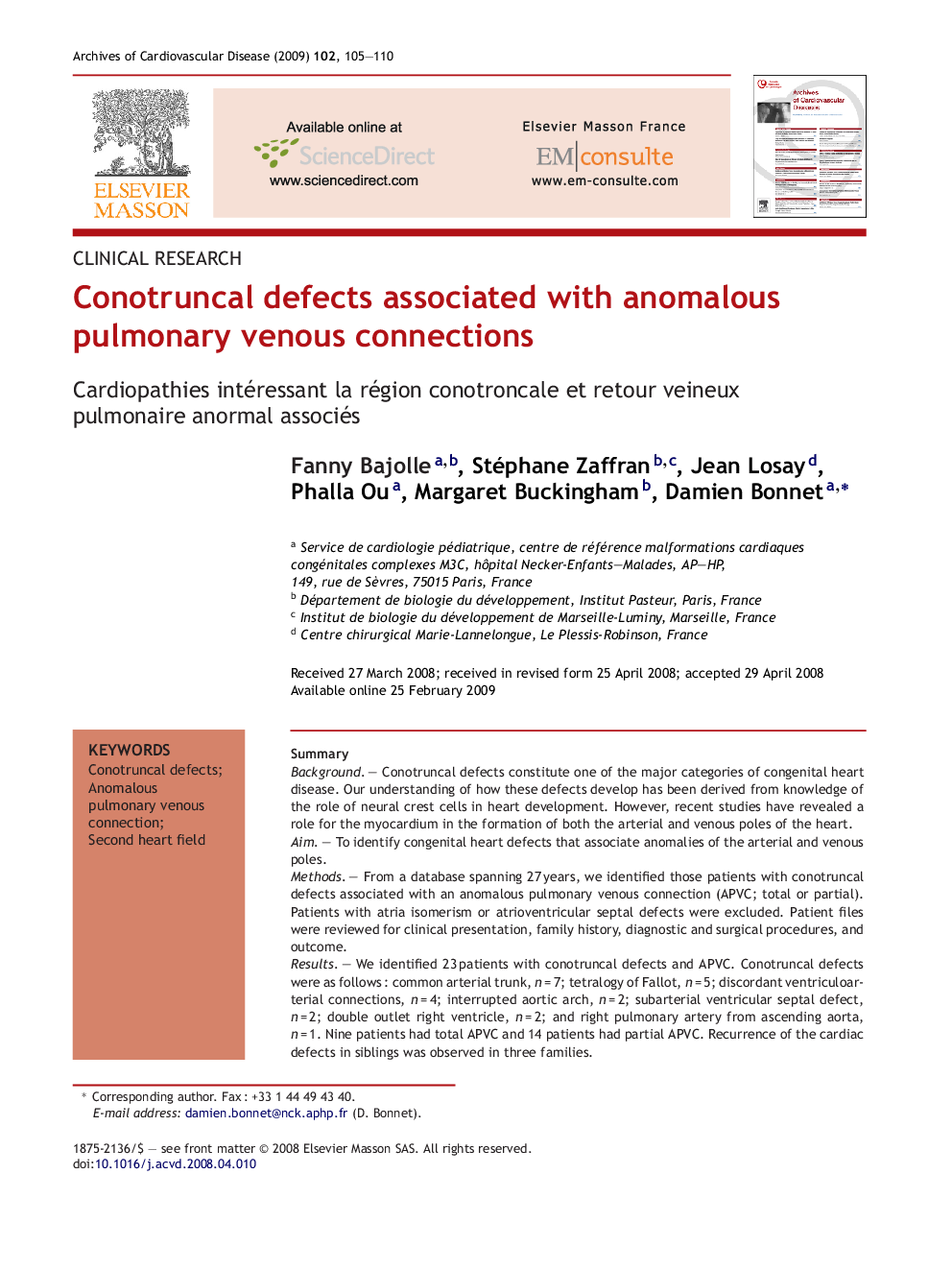| Article ID | Journal | Published Year | Pages | File Type |
|---|---|---|---|---|
| 2889640 | Archives of Cardiovascular Diseases | 2009 | 6 Pages |
SummaryBackgroundConotruncal defects constitute one of the major categories of congenital heart disease. Our understanding of how these defects develop has been derived from knowledge of the role of neural crest cells in heart development. However, recent studies have revealed a role for the myocardium in the formation of both the arterial and venous poles of the heart.AimTo identify congenital heart defects that associate anomalies of the arterial and venous poles.MethodsFrom a database spanning 27 years, we identified those patients with conotruncal defects associated with an anomalous pulmonary venous connection (APVC; total or partial). Patients with atria isomerism or atrioventricular septal defects were excluded. Patient files were reviewed for clinical presentation, family history, diagnostic and surgical procedures, and outcome.ResultsWe identified 23 patients with conotruncal defects and APVC. Conotruncal defects were as follows : common arterial trunk, n = 7; tetralogy of Fallot, n = 5; discordant ventriculoarterial connections, n = 4; interrupted aortic arch, n = 2; subarterial ventricular septal defect, n = 2; double outlet right ventricle, n = 2; and right pulmonary artery from ascending aorta, n = 1. Nine patients had total APVC and 14 patients had partial APVC. Recurrence of the cardiac defects in siblings was observed in three families.ConclusionOur findings suggest that congenital heart defects that associate anomalies of the arterial and venous poles may have a common embryology, which results from a myocardial defect.
RésuméIntroductionLes cardiopathies conotroncales constituent un des principaux groupes de cardiopathies congénitales. Leur origine embryologique a longtemps été attribuée à des anomalies des cellules de la crête neurale. Plus récemment, le rôle du myocarde dans le développement des pôles artériel et veineux du cœur a été mis en exergue.ButIdentifier les patients ayant une cardiopathie congénitale affectant les pôles artériels et veineux simultanément.MéthodesLes patients ayant une cardiopathie conotroncale et une anomalie du retour veineux pulmonaire (RVPA) ont été identifiés à partir d’une base de données couvrant une période de 27 ans. Les patients ayant un isomérisme ou un canal atrioventriculaire ont été exclus. La présentation clinique, l’histoire familiale, les méthodes diagnostiques et thérapeutiques ainsi que le devenir des patients ont été analysés.RésultatsVingt-trois patients ayant une cardiopathie conotroncale et un RVPA ont été identifiés. Les cardiopathies conotroncales étaient les suivantes : tronc artériel commun, n = 7 ; tétralogie de Fallot, n = 5 ; discordance ventriculo-artérielle, n = 4 ; interruption de l’arche, n = 2 ; communication interventriculaire conoventriculaire, n = 2 ; ventricule droit à double issue, n = 2 ; et artère pulmonaire droite aberrante, n = 1. Neuf patients avaient un RVPA total et 14 un RVPA partiel. Une récurrence de cardiopathies congénitales était notée dans trois familles.ConclusionNotre étude suggère que les cardiopathies congénitales complexes associant des anomalies des pôles artériel et veineux puissent avoir une origine embryologique commune dérivée du myocarde embryonnaire.
